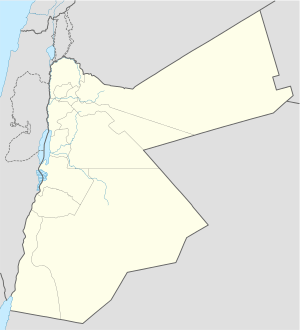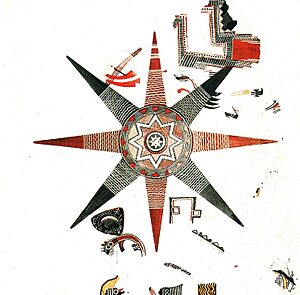Ghassulian facts for kids


The Ghassulian was an ancient culture that lived in the Southern Levant (which is now Jordan, Israel, and the Palestinian territories). This culture existed during the Middle and Late Chalcolithic Period, roughly from 4400 BC to 3500 BC. The main place where this culture was first discovered is called Teleilat el-Ghassul. This site is in the eastern Jordan Valley, close to the northern part of the Dead Sea in modern-day Jordan.
Archaeologists, including the Jesuits, Basil Hennessy, and Stephen Bourke, have dug at Teleilat el-Ghassul many times since 1929. They found out a lot about how these ancient people lived. The Ghassulian people lived in small villages and were mostly farmers. They grew crops and raised animals. Some groups, like the Beersheba culture, even built unique underground homes. They also made houses from mud-brick that were sometimes partly underground. These homes often had amazing colorful wall paintings, like the famous 'Ghassulian Star'. The Ghassulian people made very detailed pottery, including bowls with feet and horn-shaped cups, which suggests they made and drank wine. They also used stone tools but were also skilled at melting and shaping copper. When people died, they were sometimes buried in stone tombs called dolmens.
Contents
Who Were the Ghassulians?
The name "Ghassulian" comes from the important archaeological site of Teleilat el-Ghassul. This site is located northeast of the Dead Sea in the Great Rift Valley. Sometimes, the name Ghassulian is used to describe the entire Chalcolithic period in the southern Levant. More often, it refers to a specific culture found in central and southern Israel, the Palestinian territories in the West Bank, and western Jordan.
Other Chalcolithic cultures existed in different areas, like the Qatifian and Timnian cultures in dry regions, and the Golanian culture. However, the Ghassulian culture is the most well-known in this area.
Where Did They Come From?
The Ghassulian culture is the main culture of the Chalcolithic period in Israel. Many Ghassulian villages have been found at different archaeological sites. Interestingly, most of these settlements were built in areas that had not been lived in before. This suggests that the Ghassulian people might have been immigrants who brought their culture with them.
Archaeologists have found Ghassulian settlements in the Jordan Rift Valley, along the Israeli coastal plain, in the Judaean Desert, and in the northern and western Negev desert. However, it seems they did not settle in the mountainous parts of Israel or in northern Israel. Since no early stages of their culture have been found in the region, it is believed they came from somewhere else. Their exact origins are still a mystery.
Most Ghassulian settlements date back to the second half of the 5th millennium BC (around 4500-4000 BC). Many of these villages existed for only a short time. However, Teleilat el-Ghassul itself was lived in for a long time, with eight different layers of occupation from the Chalcolithic period. This shows that people lived there for many generations.
Ghassulian Copper Work
The Ghassulian people were among the first to work with copper in the region. The earliest evidence of a copper industry in Israel was found at a site called Bir abu Matar, near Beersheba. This place was special because it focused on making copper tools and other items.
There is no natural copper ore in the Beersheba area. This means the Ghassulians had to bring the raw copper from other places. They likely got it from Wadi Feynan in southern Jordan, and possibly also from Timna, where an ancient copper mine was discovered. This shows they had trade routes and advanced skills in metalworking.
When Did the Ghassulian Culture Exist?
The Ghassulian culture, especially its later period, began around the middle of the 5th millennium BC (about 4500 BC) and ended around 3800 BC. After the Ghassulian period, the Early Bronze Age I (EB I) began. Archaeologists are still studying how the Ghassulian culture changed into the Early Bronze Age culture. It seems there were some gradual changes in how people made pottery, flint tools, and metal items, especially in the southern parts of the Southern Levant.
See also
Ghassulian Sites
- Beit Eshel: Archaeology
- Chalcolithic Temple of Ein Gedi
- Nahal Mishmar, where ancient artifacts were found
Other Related Topics
- Levantine archaeology: The study of ancient times in the Syro-Palestinian region.
- Levantine archaeology: Ceramics analysis - How pottery changed over time in the Southern Levant.
- Pre-history of the Southern Levant
- Proto-Semitic language: Urheimat - Ideas about where the Proto-Semitic language might have originated.



